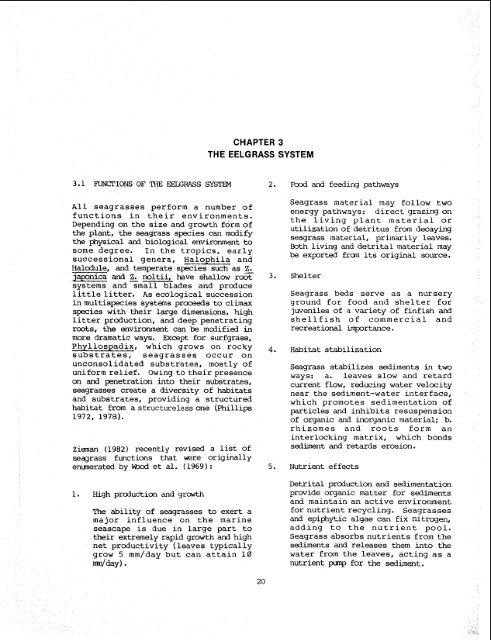The ecology of eelgrass meadows in the Pacific Northwest: A ...
The ecology of eelgrass meadows in the Pacific Northwest: A ...
The ecology of eelgrass meadows in the Pacific Northwest: A ...
- No tags were found...
You also want an ePaper? Increase the reach of your titles
YUMPU automatically turns print PDFs into web optimized ePapers that Google loves.
CHAPTER 3<br />
THE EELGRASS SYSTEM<br />
3.1 E'UNCI'IONS OF THE EET-GRASS SYSTEM 2. Food and feed<strong>in</strong>g pathways<br />
All seagrasses perform a number <strong>of</strong><br />
functions <strong>in</strong> <strong>the</strong>ir environments.<br />
Depend<strong>in</strong>g on <strong>the</strong> size and growth form <strong>of</strong><br />
<strong>the</strong> plant, <strong>the</strong> seagrass species can modify<br />
<strong>the</strong> physical and biological environment t6<br />
some degree. In <strong>the</strong> tropics, early<br />
success~onal genera, ~aio~hila an;<br />
Halcdule, and temperate species such as &<br />
japnica and - Z. noltii, have shallow root 3.<br />
systems and small blades and produce<br />
little litter. As ecological succession<br />
<strong>in</strong> multispecies systems proceeds to climax<br />
species with <strong>the</strong>ir large dimensions, high<br />
litter production, and deep penetrat<strong>in</strong>g<br />
roots, <strong>the</strong> environment can be modified <strong>in</strong><br />
more dramatic ways. Except for surfgrass,<br />
Phyllospadix, which grows on rocky 4.<br />
substrates, seagrasses occur on<br />
unconsolidated substrates, mostly <strong>of</strong><br />
uniform relief. Ow<strong>in</strong>g to <strong>the</strong>ir presence<br />
on and penetration <strong>in</strong>to <strong>the</strong>ir substrates,<br />
seagrasses create a diversity <strong>of</strong> habitats<br />
and substrates, provid<strong>in</strong>g a structured<br />
habitat from a structureless one (Phillips<br />
1972, 1978).<br />
Zieman (1982) recently revised a list <strong>of</strong><br />
seagrass functions that were orig<strong>in</strong>ally<br />
enmerated by Wxd et al. ( 1969 : 5.<br />
1. High prduction and growth<br />
<strong>The</strong> ability <strong>of</strong> seagrasses to exert a<br />
major <strong>in</strong>fluence on <strong>the</strong> mar<strong>in</strong>e<br />
seascape is due <strong>in</strong> large part to<br />
<strong>the</strong>ir extremely rapid growth and high<br />
net productivity (leaves typically<br />
grow 5 rnm/day but can atta<strong>in</strong> 18<br />
4-1<br />
Seagrass material may follow two<br />
energy pathways: direct graz<strong>in</strong>g on<br />
<strong>the</strong> liv<strong>in</strong>g plant material or<br />
utilization <strong>of</strong> detritus from decay<strong>in</strong>g<br />
seagrass material, prirnar ily leaves.<br />
Both liv<strong>in</strong>g and detrital material may<br />
be exprted £ran its orig<strong>in</strong>al source.<br />
Shelter<br />
Seagrass beds serve as a nursery<br />
ground for food and shelter for<br />
juveniles <strong>of</strong> 3 variety <strong>of</strong> f<strong>in</strong>fish and<br />
shellfish <strong>of</strong> commercial and<br />
recreational importance.<br />
Habitat stabilization<br />
Seagrass stabilizes sediments <strong>in</strong> two<br />
ways: a. leaves slow and retard<br />
current flow, reduc<strong>in</strong>g water velocity<br />
near <strong>the</strong> sediment-water <strong>in</strong>terface,<br />
which promotes sedimentation <strong>of</strong><br />
particles and <strong>in</strong>hibits resuspension<br />
<strong>of</strong> organic and <strong>in</strong>organic material; b.<br />
rhizomes and roots form an<br />
<strong>in</strong>terlock<strong>in</strong>g matrix, which bonds<br />
sediment and retards erosion.<br />
Nutrient effects<br />
Detrital production and sedimentation<br />
provide organic matter for sediments<br />
and ma<strong>in</strong>ta<strong>in</strong> an active environment<br />
for nutrientrecycl<strong>in</strong>g. Seagrasses<br />
and epiphytic algae can fix nitrogen,<br />
add<strong>in</strong>g to <strong>the</strong> nutrient pool.<br />
Seagrass absorbs nutrients from <strong>the</strong><br />
sediments and releases <strong>the</strong>m <strong>in</strong>to <strong>the</strong><br />
water from <strong>the</strong> leaves, act<strong>in</strong>g as a<br />
nutrient pt~np for <strong>the</strong> sediment.

















